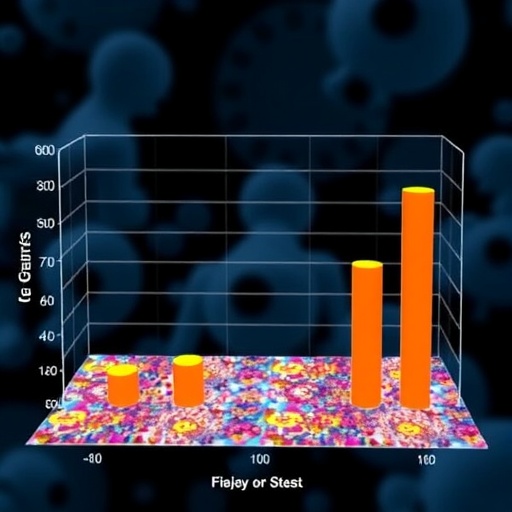Researchers from the University of Tennessee Health Science Center have made a foundational discovery about chromosome biology through their work on the first-ever human pangenome reference.

Credit: Courtesy UTHSC
Researchers from the University of Tennessee Health Science Center have made a foundational discovery about chromosome biology through their work on the first-ever human pangenome reference.
Published recently by the Human Pangenome Reference Consortium in the journal Nature, the draft pangenome uses complete genome assemblies to provide a diverse look at the genetic makeup of humans. Researchers in the UTHSC Department of Genetics, Genomics and Informatics created the technical tools to build the pangenome, and then used the tools to understand variation in parts of the genome that could not be seen before.
The pangenome project aims to map the entirety of human genetic variation to create a comprehensive reference for geneticists to use to compare DNA sequences, which can aid in the study of connections between genes and diseases. The draft reference includes the genome sequences of 47 people, and the consortium aims to increase the number to 350 by mid-2024. The milestone comes more than 20 years after the first landmark draft genome was released.
“The first version of the reference project aimed to make a single, complete version that is representative of a typical genome, which was used in biomedical research to an incredible effect over the past 20 years,” UTHSC’s Erik Garrison, PhD, said.
According to Dr. Garrison, relating a genome to the original reference could cause bias, which was understood from the beginning but could not be technically addressed. “The differences between individual genomes can be quite significant. This causes a reference bias that makes most individual genomes look more like the reference than they really are,” he said. “The goal with the human pangenome project is getting past that issue by having a reference that’s a collection of many genomes.”
In addition to Dr. Garrison, the UTHSC team included Associate Professor Pjotr Prins, PhD; Assistant Professor Vincenza Colonna, PhD; postdoctoral scholar Andrea Guarracino, PhD; PhD student Flavia Villani; postdoctoral scholar Silvia Buonaiuto, PhD; and IT analyst Christian Fischer.
The team’s biological discovery was published in a separate paper in Nature alongside the draft pangenome reference. Dr. Guarracino, Dr. Colonna, and Dr. Garrison are credited as authors.
The discovery regards the recombination of the five acrocentric chromosomes, which have centromeres closer to one end rather than in the center. Humans have two copies of most chromosomes: one inherited from the mother, and the other from the father. Recombination, the exchange of genetic material between chromosomes, is generally believed to occur between equivalent chromosome pairs, but in a significant departure from this conventional understanding, the UTHSC researchers discovered different acrocentric chromosomes can recombine with each other to exchange DNA through their shorter arms.
Furthermore, the team showed how this observation was key to solving the most common type of chromosomal abnormality in humans. A portion of the short arm of chromosome 14 is inverted relative to the other acrocentric chromosomes, and recombination with it can result in a chromosomal abnormality known as Robertsonian translocation. A Robertsonian chromosome is a fusion of two acrocentric chromosomes in a head-to-head orientation. This can cause an abnormal number of chromosome copies, which causes reproductive issues for carriers of Robertsonian translocations.
“The presence of the extra chromosome copy will cause fertility issues and is related to Down syndrome,” Dr. Garrison said. “We were able to actually provide a molecular description of why this is happening, resolving a question about the cause of Robertsonian translocations that has been open for 50 years. This will have ramifications for potential treatment, and it will help carriers understand the cause of their genetic condition.”
Dr. Guarracino suggests their methods will unlock a new wave of sequence-based cytogenetic research. “Our work addresses limitations of previous studies and lays a strong foundation for future genomic and cytogenetic research, moving us closer to resolving persistent mysteries of human genetic evolution,” he said.
The collaboration also paves the way toward considering these regions in biomedical and evolutionary studies that have previously overlooked them. “We haven’t been able to account for variation in the short arms of the acrocentrics in past studies of genome-wide association and human evolution,” Dr. Colonna said. “We show that these regions behave unusually genetically, and new approaches will be needed to leverage the information they contain into biomedical studies at the population level.”
According to the researchers, the pangenome project is just beginning. Dr. Prins said the reference will keep growing, adding that the more people who are added to it from different backgrounds, the more valuable it becomes. Not only will the team’s work apply to the study of humans, but Dr. Prins said it could also help animal researchers create a pangenome to help study species with far more variation than humans.
“People will forever be coming to us, because we wrote the tools,” Dr. Prins said. “If you build a pangenome of 100 individuals, that’s already pretty daunting, but of course in a few years, we’ll be adding thousands. So, we’ll need to improve the software that can handle these things and we may even need new methods.”
The UTHSC researchers are holding a conference and three-day course this week on the UTHSC campus in Memphis and virtually to share their expertise. Through the hands-on workshop, participants are learning about pangenome concepts and its multiple applications. The conference features presentations from leading experts in the field of pangenome research.
Journal
Nature
DOI
10.1038/s41586-023-05976-y
Article Title
Recombination between heterologous human acrocentric chromosomes
Article Publication Date
10-May-2023




